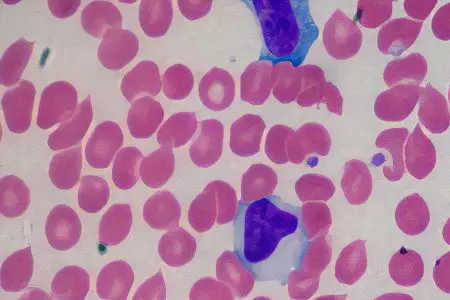Contents

Infectious mononucleosis (mononitis or glandular fever) is a disease caused by the filtering Epstein-Barr virus (B-human lymphotropic virus), belonging to the group of herpes viruses. It can be present in human cells for a long time as a latent infection.
Most often, children are susceptible to the disease, outbreaks of the disease occur all year round, but the highest incidence occurs in the autumn months. Mononucleosis is ill once, after which lifelong immunity is developed.
Causes of mononucleosis
The disease is transmitted from a sick person in the acute period, and with the erased forms of the disease, the virus carrier is also the source. Usually, infection occurs through close contact, when the virus is spread by airborne droplets, with kisses, transmission is possible through blood transfusions, while traveling in public transport, when using other people’s hygiene products.
Mononucleosis affects children with weak immunity, after suffering stress, with serious mental and physical stress. After primary infection, the virus is shed into the external space within 18 months. The duration of the incubation period is from 5 to 20 days. Half of the adult population has an infectious disease during adolescence.
In girls, infectious mononucleosis occurs at the age of 14-16 years, and boys are exposed to the disease at 16-18 years of age. Rarely, the disease affects people over 40 years of age, since antibodies to the virus are present in the blood of adults. What is the reason for the rapid development of infection in an infected organism? During the acute phase of the disease, part of the affected cells die, being released, the virus infects new, healthy cells.
In case of violation of cellular and humoral immunities, superinfection develops and a layering of a secondary infection occurs. It has been noted that the Epstein-Barr virus is capable of infecting lymphoid and reticular tissues, resulting in the appearance of generalized lymphadenopathy, enlargement of the liver and spleen.
Symptoms of mononucleosis
Mononucleosis is characterized by fever, damage to the pharynx (tonsillitis) and lymph nodes, enlarged tonsils, severe sore throat, enlarged liver and spleen, changes in blood composition, and can sometimes take a chronic course. From the first days, there is a slight malaise, weakness, headache and muscle pain, pain in the joints, a slight increase in temperature and mild changes in the lymph nodes and pharynx.
Later there is pain when swallowing. Body temperature rises to 38-40°C, it can be undulating, such temperature fluctuations persist throughout the day and can last 1-3 weeks. Tonsillitis manifests itself immediately or after a few days, it can be catarrhal with slight swelling of the tonsils, lacunar with a more severe manifestation of inflammation in both tonsils, or ulcerative necrotic with a fibrinous film, as in diphtheria.
A sharp difficulty in breathing and abundant mucous discharge, slight nasal congestion, perspiration and mucous discharge on the back of the pharynx indicate the development of nasopharyngitis. In patients, spear-shaped plaque may hang from the nasopharynx, massive loose, curd-like white-yellow overlays on the tonsils are observed.
The disease is accompanied by damage to the angular jaw and posterior cervical lymph nodes, they swell most clearly in the cervical group, along the posterior edge of the sternocleidomastoid muscle in the form of a chain or package. The diameter of the nodes can be up to 2-3 cm. Less commonly, axillary, inguinal, cubital lymph nodes increase.
The infection affects the lymph flow of the mesentery of the intestine, causes inflammation, provokes pathological rashes on the skin in the form of spots, papules, age spots. The timing of the appearance of the rash is from 3 to 5 days after three days it disappears without a trace. Recurrence of rashes usually does not happen.
There is no single systematization of clinical forms of infectious mononucleosis; there can be not only typical (with symptoms), but also atypical (without symptoms) forms of the disease. Histological examination confirms the involvement of several important organs in the process. Inflammation of the interstitial tissue of the lung (interstitial pneumonia), a decrease in the number of cellular elements of the bone marrow (hypoplasia), and inflammation of the choroid (uveitis) develop.
Clinical manifestations of the disease are poor sleep, nausea, abdominal pain, diarrhea, and sometimes vomiting. Mononucleosis is characterized by the appearance of intraperitoneal tumors, it is also associated with the occurrence of lymphatic lymphomas in patients with reduced immunity.
Diagnosis of mononucleosis

Infectious mononucleosis is quite widespread, its mild forms are difficult to diagnose. The peculiarity of this virus is that it prefers to infect the lymphoid tissue, which is in the tonsils, lymph nodes, spleen and liver, so these organs suffer the most.
During the initial examination, the doctor, according to complaints, establishes the main symptoms of the disease. If mononucleosis is suspected, a blood test (monospot test) is prescribed, which excludes other diseases that can cause similar symptoms. Accurate diagnosis is only possible through the collection of clinical and laboratory data.
In the blood count, an increase in lymphocytes and the presence of atypical mononuclear cells in the blood are usually found. Serological studies allow the detection of heterophilic antibodies to erythrocytes of various animals.
The virus is found in saliva:
after the incubation period of infection;
during its development;
6 months after recovery;
Epstein-Barr viruses in a latent form are stored in B-lymphocytes and in the mucous tissue of the oropharynx. Isolation of the virus is observed in 10-20% of patients who have had infectious mononucleosis in the past. In modern laboratories, laboratory diagnosis of the disease is performed using modern equipment using disposable sterile instruments when sampling biomaterial.
A positive result clarifies the presence of infection in the body, the transition of the disease to a chronic form, as well as the period of activation of the infectious process. Negative results mean no infection at an early stage in the course of the disease. Blood tests should be done every three days to monitor the progress of the infection.
Consequences mononucleosis
Complications from infectious mononucleosis are very rare, but if they occur, they can be very dangerous. Hematological complications include increased destruction of red blood cells (autoimmune hemolytic anemia), decreased peripheral blood platelet count (thrombocytopenia), and reduced granulocyte count (granulocytopenia).
In patients with mononucleosis, rupture of the spleen, obstruction of the airways can occur, which sometimes leads to death. There is a danger from a variety of neurological complications – from encephalitis, paralysis of the cranial nerves, damage to the facial nerve and, as a result, paralysis of the mimic muscles. Meningoencephalitis, Guillain-Barré syndrome, multiple nerve lesions (polyneuritis), transverse myelitis, psychosis, cardiac complications, interstitial pneumonia are also among the complications of mononucleosis.
After an illness, children usually get tired for about half a year, they need to sleep more, including during the daytime. Such students should be less loaded with classes at school.
Treatment and prevention

Symptomatic therapy is used in the treatment of mononucleosis. During the period of fever, antipyretic drugs and plenty of fluids are used. With the help of vasoconstrictor drugs, such as ephedrine, galazolin, etc., they relieve difficulty in nasal breathing.
They use desensitizing drugs that prevent or weaken allergic reactions, interferon, various immunostimulants or other effective antiviral drugs that are in the arsenal of doctors. Patients are prescribed gargling with warm solutions of furacilin, soda solution and salt water.
Ibuprofen, acetaminophen is recommended to relieve headaches and reduce fever. To eliminate pain, reduce swelling of the tonsils, throat and spleen, it is advisable to take corticosteroids, always under the constant supervision of the attending physician. Special preventive measures for mononucleosis are the same as for SARS. An important role is played by the increase in immunity and the mobilization of the internal forces of the human body.
It is believed that for the treatment of mild and moderate forms of the disease, the patient’s stay at rest, i.e., bed rest, moderate nutrition. It is necessary to select dietary products so as not to overload the affected liver. Nutrition should be fractional (4-5 times a day) with a full content of proteins, vegetable fats, carbohydrates, vitamins.
Therefore, preference is given to dairy products, lean fish and meat, fruits, sweet berries, vegetables and soups from them. You can eat cereals, wholemeal bread. The child is prohibited from butter, fried, smoked, pickled foods, canned food, pickles, spicy seasonings. Outdoor walks, a calm, joyful atmosphere in the house, and a good mood will benefit.
Regular consultations with a hepatologist will not interfere with the child, and exemption from preventive vaccinations is mandatory. Hypothermia and overheating, physical activity, sports are contraindicated, it is useful to engage in physiotherapy exercises.









